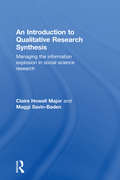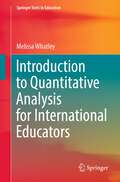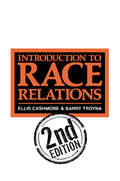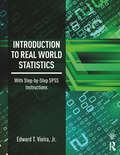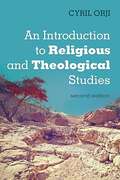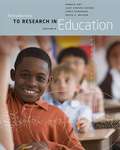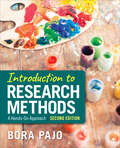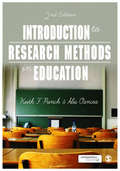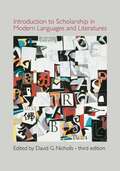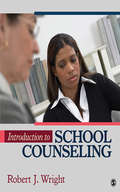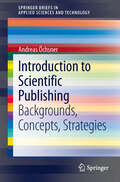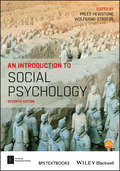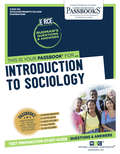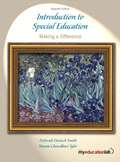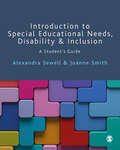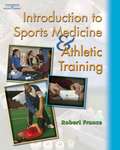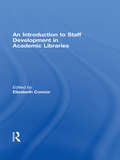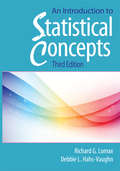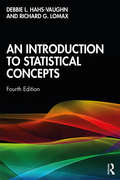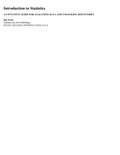- Table View
- List View
An Introduction to Qualitative Research Synthesis: Managing the Information Explosion in Social Science Research
by Claire Howell Major Maggi Savin-BadenProviding a comprehensive guide for understanding, interpreting and synthesizing qualitative studies, An Introduction to Qualitative Research Synthesis shows how data can be collated together effectively to summarise existing bodies of knowledge and to create a more complete picture of findings across different studies The authors describe qualitative research synthesis and argue for its use, describing the process of data analysis, synthesis and interpretation and provide specific details and examples of how the approach works in practice. This accessible book: fully explains the qualitative research synthesis approach; provides advice and examples of findings; describes the process of establishing credibility in the research process; provides annotated examples of the work in process; references published examples of the approach across a wide variety of fields. Helping researchers to understand, make meaning and synthesize a wide variety of datasets, this book is broad in scope yet practical in approach. It will be beneficial to those working in social science disciplines, including researchers, teachers, students and policy makers, especially those interested in methods of synthesis such as meta-ethnography, qualitative meta-analysis, qualitative meta-synthesis, interpretive synthesis, narrative synthesis, and qualitative systematic review.
Introduction to Quantitative Analysis for International Educators (Springer Texts in Education)
by Melissa WhatleyThis textbook introduces international education scholars, professionals and graduate students to quantitative research methods. It provides them with the most foundational and useful concepts in quantitative analysis, using international education themes for all examples and practice problems. Readers will have a foundation to pursue more advanced methods and analyses, whether through formal training or future individual study.The book assumes no prior knowledge of quantitative analysis and is written for individuals who are new to statistics. Practice problems are found at the end of all substantive chapters, and datasets are provided so that readers can practice the analyses that are presented. Moreover, in each chapter, different statistical approaches are illustrated with real examples from international education research. These examples provide context for each statistical method and represent a wide variety of contexts in international education research, covering a variety of international education topics and a variety of regions of the world. From the instructor perspective, these example studies could be used as additional course reading. Moreover, supplemental material provides slides that instructors can modify and use in conjunction with the text.
Introduction To Race Relations
by Barry TroynaThis is the second edition of the textbook on race and ethnic relations, which has been adopted by academic and vocational courses and which is designed to be a straightforward introduction to this field of study. It retains all the original features, but reflects on events over the years since its original publication, incorporating accounts of developments in the UK and USA. Suggestions for further readings are revised in the light of the latest research.
Introduction to Real World Statistics: With Step-By-Step SPSS Instructions
by Edward T. Vieira Jr.Introduction to Real World Statistics provides students with the basic concepts and practices of applied statistics, including data management and preparation; an introduction to the concept of probability; data screening and descriptive statistics; various inferential analysis techniques; and a series of exercises that are designed to integrate core statistical concepts. The author’s systematic approach, which assumes no prior knowledge of the subject, equips student practitioners with a fundamental understanding of applied statistics that can be deployed across a wide variety of disciplines and professions. Notable features include: short, digestible chapters that build and integrate statistical skills with real-world applications, demonstrating the flexible usage of statistics for evidence-based decision-making statistical procedures presented in a practical context with less emphasis on technical jargon early chapters that build a foundation before presenting statistical procedures SPSS step-by-step detailed instructions designed to reinforce student understanding real world exercises complete with answers chapter PowerPoints and test banks for instructors.
An Introduction to Reference Services in Academic Libraries
by Elizabeth ConnorAn introductory text on various aspects of reference services that requires your students to think!An Introduction to Reference Services in Academic Libraries is a comprehensive textbook that presents compelling case studies and thought-provoking essays that teach the principles of reference services. Eighteen authorities from private and public ac
An Introduction to Religious and Theological Studies
by Cyril OrjiAn Introduction to Religious and Theological Studies walks students through topical issues to be encountered in the study of the Abrahamic religions: Judaism, Christianity, and Islam as these religions encounter other religions in the context of the wider ecumenism. The text is written from a Christian point of view and aims at helping students understand that to be Christian is to be ecumenical. African Traditional Religions (ATRs) has been included in this survey to provide background for the religious traditions and cultures of peoples of Africa as Christianity moves inexorably southward. The book has been written with undergraduate general education students in mind—including meeting the needs of those in seminaries and theological institutes.
Introduction to Research in Education (Ninth Edition)
by Donald Ary Lucy Cheser Jacobs Christine K. Sorensen David WalkerBecome a more competent consumer and producer of research with INTRODUCTION TO RESEARCH IN EDUCATION, 9th Edition! Known for its exceptionally clear writing style and comprehensive coverage, this research methods guide helps you master the basic competencies necessary to understand and evaluate the research of others. The authors familiarize you with common research problems in a step-by-step manner through examples that clarify complex concepts, supported by strong end-of-chapter exercises. This book is a must-read for anyone planning to conduct research or interpret the research of others.
Introduction to Research Methods: A Hands-on Approach
by Bora PajoThe Second Edition of Introduction to Research Methods: A Hands-On Approach by Bora Pajo continues to make research easy to understand and easy to construct. Covering both quantitative and qualitative methods, this new edition lays out the differences between research approaches so readers can better understand when and how to use each research design. Through clear, simple, and even humorous prose, this text offers students a straightforward introduction to a new world of social science research. Rather than making research seem intimidating, Introduction to Research Methods shows students that research is an ongoing conversation concerning topics that matter in their lives, a conversation that′s easy to understand and easy to join. The new edition features updated chapters on qualitative designs and qualitative data analysis, a new chapter on big data and digital methods, and updated citation and report styles for APA Style 7th Edition. This title is accompanied by a complete teaching and learning package in SAGE Vantage, an intuitive learning platform that integrates quality SAGE textbook content with assignable multimedia activities and auto-graded assessments to drive student engagement and ensure accountability. Unparalleled in its ease of use and built for dynamic teaching and learning, Vantage offers customizable LMS integration and best-in-class support.
Introduction to Research Methods: A Hands-on Approach
by Bora PajoThe Second Edition of Introduction to Research Methods: A Hands-On Approach by Bora Pajo continues to make research easy to understand and easy to construct. Covering both quantitative and qualitative methods, this new edition lays out the differences between research approaches so readers can better understand when and how to use each research design. Through clear, simple, and even humorous prose, this text offers students a straightforward introduction to a new world of social science research. Rather than making research seem intimidating, Introduction to Research Methods shows students that research is an ongoing conversation concerning topics that matter in their lives, a conversation that′s easy to understand and easy to join. The new edition features updated chapters on qualitative designs and qualitative data analysis, a new chapter on big data and digital methods, and updated citation and report styles for APA Style 7th Edition. This title is accompanied by a complete teaching and learning package in SAGE Vantage, an intuitive learning platform that integrates quality SAGE textbook content with assignable multimedia activities and auto-graded assessments to drive student engagement and ensure accountability. Unparalleled in its ease of use and built for dynamic teaching and learning, Vantage offers customizable LMS integration and best-in-class support.
Introduction to Research Methods in Education
by Keith F Punch Dr Alis E. OanceaBased on Keith Punch's bestselling Introduction to Social Research Methods, this book introduces the research process in a range of educational contexts. In this updated second edition, you'll find guidance on every stage of research, with chapters on developing research questions, doing a literature review, collecting data, analysing your findings and writing it all up. With a new chapter on ethics and additional coverage of Internet research and mixing methods, the second edition contains everything you'll need if you're studying on a research methods course or doing a research project for yourself. Introduction to Research Methods in Education provides you with: Balanced coverage of the range of methods employed by educational researchers Practical advice on collecting and analysing qualitative, quantitative and mixed methods data A range of examples from student projects to show how research is done in real-life educational settings A companion website with additional resources for lecturers and students. Keith F Punch is Emeritus Professor in the Graduate School of Education at The University of Western Australia. Alis Oancea is Professor of Philosophy of Education and Research Policy, as well as Director of Research at the University of Oxford, Department of Education.
Introduction to Research Methods in Educaton
by Keith F PunchIntroduction to Research Methods in Education focuses on helping the reader develop a clear, logical, and conceptual understanding of the nature of empirical research in education, and of how those ideas lead to and underlie the principal research techniques. Qualitative, quantitative, and mixed methods approaches are covered, along with practical guidance on issues such as how to prepare a research proposal, write a literature review, and analyze different types of data.
Introduction to Rubrics: An Assessment Tool to Save Grading Time, Convey Effective Feedback, and Promote Student Learning
by Dannelle D. StevensThis new edition retains the appeal, clarity and practicality that made the first so successful, and continues to provide a fundamental introduction to the principles and purposes of rubrics, with guidance on how to construct them, use them to align course content to learning outcomes, and apply them in a wide variety of courses, and to all forms of assignment. Reflecting developments since publication of the first edition, the authors have extended coverage to include:* Expanded discussion on use of rubrics for grading* Grading on-line with rubrics* Wider coverage of rubric types (e.g., holistic, rating scales)* Rubric construction in student affairs* Pros and cons of working with "ready-made" rubrics* Using rubrics to improve your teaching, and for SoTL* Use of rubrics in program assessment (case study)* Application of rubrics in the arts, for study abroad, service learning and students’ independent learning * Up-dated literature review
Introduction to Scholarship in Modern Languages and Literatures
by David G. NichollsThe third edition of the MLA's widely used Introduction to Scholarship in Modern Languages and Literatures features sixteen new essays by leading scholars. Designed to highlight relations among languages and forms of discourse, the volume is organized into three sections. "Understanding Language" provides an overview of the field of linguistics, with special attention to language acquisition and the social life of languages. "Forming Texts" offers tools for understanding how speakers and writers shape language; it examines scholarship in the distinct but interrelated fields of rhetoric, composition, and poetics. "Reading Literature and Culture" continues the work of the first two sections by introducing major areas of critical study. The nine essays in this section cover textual and historical scholarship; interpretation; comparative, cultural, and translation studies; and the interdisciplinary topics of gender, sexuality, race, and migrations (among others). As in previous volumes, an epilogue examines the role of the scholar in contemporary society.Each essay discusses the significance, underlying assumptions, and limits of an important field of inquiry; traces the historical development of its subject; introduces key terms; outlines modes of research now being pursued; postulates future developments; and provides a list of suggestions for further reading. This book will interest any member of the academic community seeking a review of recent scholarship, while it provides an indispensable resource for undergraduate and graduate students of modern languages and literatures.
Introduction to School Counseling
by Robert J. WrightThis comprehensive graduate-level text prepares readers to handle the problems and responsibilities they'll face as professional school counselors, preschool through high school. It covers a wide range of topics in-depth, including: effective interventions for racism and bullying, the continuing score gap between ethnic groups, a school counselor's leadership role in implementing school-based action research, a model for advocating on behalf of, and providing services to children with disabilities. The book is packed with real life examples and case descriptions: it provides strategies for preventing and responding to social and emotional problems, improving educational outcomes, and helping children score at optimum levels on high-stakes tests.
Introduction to Scientific Publishing: Backgrounds, Concepts, Strategies
by Andreas ÖchsnerThis book is a very concise introduction to the basic knowledge of scientific publishing. It starts with the basics of writing a scientific paper, and recalls the different types of scientific documents. In gives an overview on the major scientific publishing companies and different business models. The book also introduces to abstracting and indexing services and how they can be used for the evaluation of science, scientists, and institutions. Last but not least, this short book faces the problem of plagiarism and publication ethics.
An Introduction to Social Psychology (BPS Textbooks in Psychology)
by Miles Hewstone Wolfgang StroebeThis definitive resource in social psychology includes engaging study tools designed to help students grasp the underlying theories and the latest research in the field. In the 7th edition of An Introduction to Social Psychology, students will discover a wealth of tools to help them understand the theories and fundamental knowledge in the ever-evolving field of social psychology. With contributions leading psychologists, this feature-rich edition includes Theory Boxes, Research Close-ups, and Lab Boxes to help cement students’ understanding of the study material. This essential study guide has been engaging and educating students on social psychology theories and research for over 34 years. For students entering into the world of social psychology for the first time, this book covers foundational topics, such as: ● The history of social psychology throughout Europe ● Updated research methods and newly developed theories ● In-depth looks at social cognition, aggression, prosocial behavior, and relationships ● Strategies for changing attitude and behavior ● Critical study materials for multiple-choice testing The combination of traditional academic study with cohesion of topics, accessibility of material, and pedagogy in this 7th edition makes it a definitive resource for both instructors and beginning psychology students alike.
Introduction to Sociology: Passbooks Study Guide (Excelsior/Regents College Examination Series #F No. 45)
by National Learning CorporationThe Excelsior/Regents College Examinations (E/RCE) offer you an opportunity to obtain recognition for college-level learning and consists of exams designed to demonstrate achievement and mastery of various college-level subjects, such as the Arts and Sciences, Business, Criminal Justice, Education, Health and Nursing. The E/RCE Introduction to Sociology Passbook® prepares you by sharpening knowledge of the skills and concepts necessary to succeed on the upcoming exam and the college courses that follow. It provides a series of informational texts as well as hundreds of questions and answers in the areas that will likely be covered on your upcoming exam.
Introduction to Special Education: Making a Difference (7th edition)
by Deborah Deutsch Smith Naomi Chowdhuri TylerStudents and teachers have long relied on this comprehensive overview of the field of special education and the ways in which all teachers can help students with special needs to succeed in school and reach their full potential.
Introduction to Special Educational Needs, Disability and Inclusion: A Student′s Guide
by Alexandra Sewell Joanne SmithThis essential textbook equips you with a strong understanding of theories, policies and practices and how they impact on Special Educational Needs and Disabilities, guiding you through your SEND course or modules. It provides you with the foundations and tools necessary to think critically about the issues and developments concerning SEND, inclusion, and professional practice. The book includes: - Material surrounding mental health in childhood and adolescence - Chapters on global perspectives of SEND, and assistive technologies - Practical case studies, reflection questions and activities - Spotlights on key theories and research - Up-to-date information on policies impacting SEND
Introduction to Special Educational Needs, Disability and Inclusion: A Student′s Guide
by Alexandra Sewell Joanne SmithThis essential textbook equips you with a strong understanding of theories, policies and practices and how they impact on Special Educational Needs and Disabilities, guiding you through your SEND course or modules. It provides you with the foundations and tools necessary to think critically about the issues and developments concerning SEND, inclusion, and professional practice. The book includes: - Material surrounding mental health in childhood and adolescence - Chapters on global perspectives of SEND, and assistive technologies - Practical case studies, reflection questions and activities - Spotlights on key theories and research - Up-to-date information on policies impacting SEND
Introduction to Sports Medicine and Athletic Training
by Robert C. FranceIntroduction to Sports Medicine & Athletic Training is a book written for individuals interested in athletics and the medical needs of athletes. This book is unique in that it covers four distinct disciplines in an easy to understand format. The four disciplines covered include: Sports Medicine, Athletic Training, Anatomy, and Physiology. This all-in-one resource allows the individual to grasp the concepts of anatomy and physiology, and then apply them to Sports Medicine and Athletic Training. Each discipline is fully presented, and uniquely sequenced together to give the user a full understanding of this exciting field. There are comprehensive chapters on nutrition and sports psychology. Instructors will enjoy the depth of the material covered and the ease in which it is presented. Introduction to Sports Medicine & Athletic Training is the first full-concept book ever written that an entire course can be created around.
An Introduction To Staff Development In Academic Libraries
by Elizabeth ConnorAn indispensable resource for librarians of all roles, the case studies in An Introduction to Staff Development in Academic Libraries demonstrate the necessity and value of integrating the library's mission statement and strategic plan with bold approaches to staff orientation, training, mentoring, and development.
An Introduction to Statistical Concepts: Third Edition
by Debbie L. Hahs-Vaughn Richard G. LomaxThis comprehensive, flexible text is used in both one- and two-semester courses to review introductory through intermediate statistics. Instructors select the topics that are most appropriate for their course. Its conceptual approach helps students more easily understand the concepts and interpret SPSS and research results. Key concepts are simply stated and occasionally reintroduced and related to one another for reinforcement. Numerous examples demonstrate their relevance. This edition features more explanation to increase understanding of the concepts. Only crucial equations are included.In addition to updating throughout, the new edition features: New co-author, Debbie L. Hahs-Vaughn, the 2007 recipient of the University of Central Florida's College of Education Excellence in Graduate Teaching Award. A new chapter on logistic regression models for today's more complex methodologies. More on computing confidence intervals and conducting power analyses using G*Power. Many more SPSS screenshots to assist with understanding how to navigate SPSS and annotated SPSS output to assist in the interpretation of results. Extended sections on how to write-up statistical results in APA format. New learning tools including chapter-opening vignettes, outlines, and a list of key concepts, many more examples, tables, and figures, boxes, and chapter summaries. More tables of assumptions and the effects of their violation including how to test them in SPSS. 33% new conceptual, computational, and all new interpretative problems. A website that features PowerPoint slides, answers to the even-numbered problems, and test items for instructors, and for students the chapter outlines, key concepts, and datasets that can be used in SPSS and other packages, and more. Each chapter begins with an outline, a list of key concepts, and a vignette related to those concepts. Realistic examples from education and the behavioral sciences illustrate those concepts. Each example examines the procedures and assumptions and provides instructions for how to run SPSS, including annotated output, and tips to develop an APA style write-up. Useful tables of assumptions and the effects of their violation are included, along with how to test assumptions in SPSS. 'Stop and Think' boxes provide helpful tips for better understanding the concepts. Each chapter includes computational, conceptual, and interpretive problems. The data sets used in the examples and problems are provided on the web. Answers to the odd-numbered problems are given in the book. The first five chapters review descriptive statistics including ways of representing data graphically, statistical measures, the normal distribution, and probability and sampling. The remainder of the text covers inferential statistics involving means, proportions, variances, and correlations, basic and advanced analysis of variance and regression models. Topics not dealt with in other texts such as robust methods, multiple comparison and nonparametric procedures, and advanced ANOVA and multiple and logistic regression models are also reviewed.Intended for one- or two-semester courses in statistics taught in education and/or the behavioral sciences at the graduate and/or advanced undergraduate level, knowledge of statistics is not a prerequisite. A rudimentary knowledge of algebra is required.
An Introduction to Statistical Concepts: Third Edition
by Debbie L. Hahs-Vaughn Richard G. LomaxThe new edition of An Introduction to Statistical Concepts, is designed to help students really understand statistical concepts, the situations in which they can be used, and how to apply them to data. Hahs-Vaughn and Lomax discuss the most popular, along with many of the lesser-known, procedures and models, whilst also exploring nonparametric procedures used when standard assumptions are violated. They provide in-depth coverage of testing assumptions and highlight several online tools for computing statistics (e.g., effect sizes and their confidence intervals and power). This comprehensive, flexible and accessible text includes a new chapter on mediation and moderation; expanded coverage of effect sizes; discussions of sensitivity, specificity, false positive, and false negative, along with using the receiver operator characteristic (ROC) curve. This book, noted for its crystal-clear explanations, and its inclusion of only the most crucial equations, is an invaluable resource for students undertaking a course in statistics in any number of social science and behavioral disciplines—from education, business, communication, exercise science, psychology, sociology and more.
Introduction To Statistics: An Intuitive Guide For Analyzing Data And Unlocking Discoveries
by Jim FrostBuild a solid foundation in data analysis. Be confident that you understand what your data are telling you and that you can explain the results to others! I'll help you intuitively understand statistics by using simple language and deemphasizing formulas. This guide starts with an overview of statistics and why it is so important. We proceed to essential statistical skills and knowledge about different types of data, relationships, and distributions. Then we move to using inferential statistics to expand human knowledge, how it fits into the scientific method, and how to design and critique experiments.
